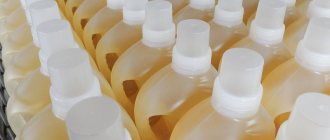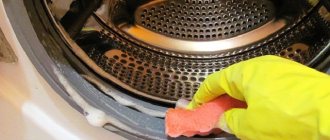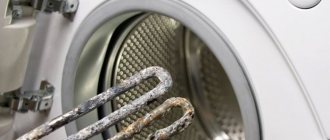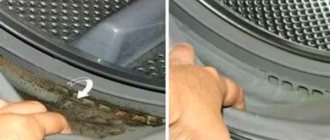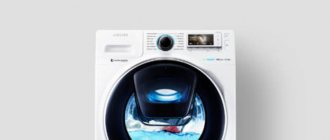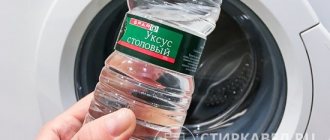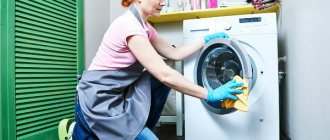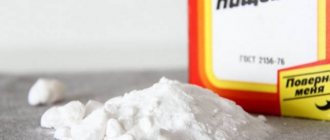Cleaning the body, door and sealing rubber
The rubber seal or cuff of the washing machine is a mandatory element of cleaning during the maintenance process. Rubber should be cleaned carefully, but efficiently, so that there are no leakage problems. Dirt and mold accumulate in this place - which is why it is important to clean regularly. Sediments in this area contribute to the appearance of unpleasant odors.
Any cleaning agent will help in the process, including regular baking soda. In some cases, if mold and a strong smell have already appeared, then it is worth using household chemicals:
- "Domestos".
- "Comet".
- “Whiteness” - it cannot be used often, as this leads to the destruction of the rubber seal. As a result, it will need to be changed.
The order for different means does not differ; it looks like this:
- Apply the product to the sponge.
- Carefully unscrew the cuff of the washing machine towards you.
- Wipe the metal elements of the housing.
- Clean the rubber itself. And not only in the lower part, where dirt accumulates the most, but throughout the entire diameter.
Important! Do not rub very hard so as not to damage the elastic band and other elements of the machine.
You also need to clean the car door. This can be done using a vinegar solution; you will need a 50% concentration of vinegar essence. It’s not difficult to prepare – just take equal parts of essence and water and mix well. All that remains is to wipe the glass and wipe it dry with a dry cloth. Gloves should be used when working with the solution.
The external elements of the washing machine should be wiped with a damp sponge; if necessary, you can use the existing cleaning agent.
Ways to clean the outer casing
If rust appears on the body of the washing machine, but the body is not rusted through, then it will need to not only be cleaned, but also painted. Cleaning and painting is carried out as follows:
- The surface with peeling paint and traces of corrosion must be cleaned using sandpaper (80 grit is suitable) or a grinder.
- Remove rust residues using a special “Tsiankovka” solvent. It is sold in spray form. The spray is applied to the cleaned surface and rubbed with a hard synthetic brush (an old toothbrush or one for cleaning clothes will do). Then wipe dry with a napkin.
- Cover the drum, door and areas of the body that are not damaged by corrosion with cellophane or cloth to prevent paint from getting on them.
- Warm up the surface with a hairdryer. Primer and paint adhere better to a heated surface and last longer.
- Apply primer in two layers. Between the first and second, pause for 10-15 minutes so that the first layer has time to dry. For work it is better to use primer and paint in cans. They are easy to apply and dry quickly.
- After the primer has dried, apply paint. The paint should be enamel for metal surfaces and the same color as the body of the washing machine. After a day, the machine can already be connected.
A housing with rusted holes will either have to be completely replaced or the holes will have to be welded.
If the machine has been brought to this state, then you can help solve the problem by contacting a specialist or replacing the metal body completely. It is not uncommon to see traces of rust on the plastic parts of the washing machine. The appearance of brown spots and smudges can be either a sign of corrosion of the metal body or a consequence of poor quality water. You can clean your car from rust from plastic and return it to its original appearance using Domestos, Comet or Mister Muscle. Any product for cleaning the surface from scale and rust is suitable. Apply and rinse with a sponge after 5-10 minutes.
Cleaning the powder tray
Before cleaning this component of the washing machine, it must be removed. If you don’t remember how to do this, it’s better to look in the instructions for the device so as not to break anything in the process. If you can’t remove the tray (this happens), you can still clean it, but you will need to pre-soak it. There are many places in the tray that are difficult to reach. To soak, you need to make a solution of any detergent and spray the tray with a spray bottle, leave for 2-3 hours. After this, cleaning will be much easier.
If you managed to remove the tray, then everything is even easier. If residues of powder or other product are found inside, it should be removed. This element needs cleaning, as over time a coating of rust, powder and other products forms on it. The following will help in removing all this plaque:
- Soda-vinegar mixture - proportions 1:2.
- Hot water + baking soda + vinegar - you need 3 parts water, 1 part baking soda and 2 parts vinegar.
Having prepared the product, it should be applied to all elements of the tray and left for 2-3 hours. Only then start cleaning with a sponge (large elements) and a toothbrush (hard-to-reach places). All that remains is to rinse the tray under running water and let it dry or wipe it dry.
Advice! If you have a dishwasher, you can wash the tray in it. It will not help get rid of plaque completely, but after such preliminary cleaning it will be easier to remove dirt.
Pollution prevention
To ensure that the container and other compartments of the machine remain clean, the equipment must be properly cared for:
- Use good detergents. Low-quality gels and powders, as a rule, do not completely dissolve in water, which leads to troubles and even breakdowns.
- Clean the powder and conditioner compartment regularly.
- After each wash, remove the detergent compartment from the machine to allow it to dry.
- Install a water softener. It will help extend the life of the detergent container. Less contamination will form on the walls of the dispenser.
If the plaque inside the tray has hardened to such an extent that it cannot be removed, the only way out is to install a new dispenser. However, if you regularly clean it of scale and plaque formations, such problems will not arise.
Cleaning the filter
The drain pump filter is an important part of the machine; if you do not pay proper attention to it, sooner or later a blockage will form and the washing machine will not drain water at all. There is no need to invent any complicated cleaning methods, everything is extremely simple. To do this, you will need a small container, a towel or rag, or any flat object that will help open the hatch.
The order is:
- Open the hatch to gain access to the filter drain hose.
- Before unscrewing the filter, lay down a rag (towel) and place a container - a small volume of water will flow out of the hole. Maximum - 0.5 l, very rarely more.
- After removing the lid (unscrewing it completely), you need to remove accumulated debris, dirt, sometimes there are coins, wool and other foreign objects.
- Wipe the hole, rinse the lid, reassemble in reverse order.
The washing machine also has a water inlet filter, which should also be cleaned. Over time, clogging with rust and sand occurs. If these deposits are critical, then an error appears on the machine screen, which can be interpreted as “water collection is impossible.”
Important! The hose located directly on the water supply should be cleaned no more than 2-3 times a year.
The process looks like this:
- Close the water supply tap to the device.
- Open access to the back cover; often the device needs to be unfolded.
- The water supply hose is located at the top right.
- You should unscrew the nut that secures it counterclockwise.
- You can see a mesh filter inside. It should be removed and washed with a toothbrush under running water.
- All that remains is to put the filter in place and screw on the hose.
How to clean different types of plastic?
White plastic is the most picky. Rust from its surface can be removed using products that have bleaching properties, for example, hydrogen peroxide is allowed.
The situation is more complicated with colored products. Incorrect use of aggressive substances will lead to stains on the plastic.
Glossy plastic panels are resistant to contact with solvents and any abrasives. To process them, it is better to use the most gentle substances, for example, lemon juice. Otherwise, the product will lose its protective film.
How to remove scale with citric acid
The biggest enemy of the internal parts of the machine is scale. You can fight it with the help of special chemicals, or you can use citric acid.
The main object is the heating element or heating element. For him, scale has a detrimental effect. Citric acid will also effectively remove scale from all metal elements of the washing machine. The procedure is simple, you don’t even have to use a rag or sponge, it consists of the following steps:
- Free the device from all things.
- Pre-rinse the cuff and door glass.
- Pour citric acid into the powder compartment. For cars with a volume of 5 kg - 100 g, 6 kg - 120 g.
- Turn on the washing machine at +90⁰ and the longest program.
- Once the cycle is completed, the cleaning is also completed.
The main protection of heating elements is timely descaling.
Important! There are special products for removing scale, for example the domestic “Antinakipin” and “Doctor TEN”. To soften water and prevent scale formation, use Calgon or its cheaper analog Refine.
Citric acid not only removes scale, but also helps get rid of unpleasant odors and mold.
You can also descale your washing machine with vinegar. This method is extremely simple, very similar to the option with citric acid. The work will require 9% vinegar, which must be poured into the powder compartment in an amount of 100 ml. The machine should be started at the longest and highest temperature setting. When the water heats up, stop the cycle for 1.5 hours, then allow the process to complete.
Product Impact Benefits
Lemon acid
Upon contact with the drum and other parts of the machine, it removes scale, grease residue, soap scum and mold. Low cost. Does not require physical effort, since it is used in automatic mode. Does not harm unit parts.
Chlorine bleach (white)
Baking soda Vinegar concentrate (acid) Cleans the drum and other machine parts from dirt and scale. Low cost.
Removes scale and other types of dirt. Low cost. High level of efficiency. Automatic cleaning mode. Cleans the walls of the drum from dirt, but does not affect the heating element (heating element) and the tank. Low cost. Harmless to device parts. Efficient in drum cleaning. High level of efficiency. The cleaning mode is automatic.
[custom_ads_shortcode2]
Cleaning the drum with baking soda
The drum is easy to clean; to do this, you need to prepare a paste of water and soda. Apply it to the drum using a sponge and rub. After cleaning, rinse with water and wipe dry. Soda perfectly helps to cope with mold and fungi, which happily settle in such comfortable conditions. To prevent the formation of mold with this simple remedy, you should clean your washing machine at least once a week.
Advice! In a similar way, you can clean the drum inside the device with Domestos.
Traditional methods
Improvised products are cheaper than special household chemicals, but they will only help remove minor blockages and odors. Not all methods can be used: there are harmful and useless cleaning products, for example Coca-Cola, sand, sugar, “Mole” pipe cleaner, vodka, aspirin. Better try safe and effective home remedies from our selection. But please note: they cannot be used often. Repeated use can damage plastic, rubber seals and metal.
Soda
It will help cope with any dirt and mold, and eliminate unpleasant odors. To process, mix baking soda with a little water to form a paste. The cleaner can be used to clean the detergent dispenser, drum or seal. If mold is found, apply the mixture to the stain for an hour and then remove with a damp cloth.
Baking soda can be replaced with soda ash. This is a more potent drug, so when using it you need to wear a respirator and gloves, and carefully follow the dosage. How to use the product:
- Prepare a cleaning solution: mix 100 g of soda ash and 100 g of clean water at room temperature.
- Apply the mixture to the drum and rubber seal - this is where bacteria, mold and other contaminants most often accumulate.
- Leave the mixture for half an hour, then remove the residue with a sponge and wipe the drum and other elements well with a damp cloth.
- Run the wash with an empty drum to remove any remaining soda ash.
Table vinegar
The product is effective in combating mold and odor. Pour a glass of 9% vinegar into the conditioner container and run the mode with maximum temperature and washing time. You can additionally turn on rinsing. If you can't stand the smell of vinegar, replace it with citric acid.
To clean heavy stains, you can use a mixture of baking soda and vinegar:
- Mix half a glass of soda with a glass of water.
- Pour the mixture into a container for washing powder.
- Pour a glass of 9% vinegar into the drum.
- Turn on the machine on the most intense mode with high temperature.
Chlorine
Whiteness, Domestos and other chlorine-containing products clean and disinfect the washing machine well. To process, pour 1 cup of product into the drum and run a full wash cycle. If after the procedure there is a strong smell of chlorine, turn on the rinse with conditioner.
How to clean mold from a washing machine
As already mentioned, you can use baking soda and citric acid to clean mold from your washing machine. Will also help:
- Whiteness . You will need to pour 1 liter of product into the compartment and turn it on at the highest temperature of at least 60⁰. When the temperature is at its maximum, stop the cycle for 2 hours. After this time, allow the cycle to complete. The use of this cleaning material should not be too frequent, as it has an aggressive effect on some parts of the machine.
- Soda Ash. The cleaning process is the same as usual, but it is worth remembering that this substance is aggressive, so you need to use personal protective equipment during the process. For prevention, it is recommended to add soda ash at each washing cycle.
What not to do
When rust appears on a washing machine, it is necessary to analyze the conditions of its maintenance. If the room is too humid, the surfaces and parts of the machine will inevitably rust, and the top panel of the unit will rust first. Therefore, it is not recommended to use the washing machine indoors in open water tanks and at high air humidity.
Rusty stains that appear on the machine indicate poor quality of water used for washing. Its composition needs to be improved; it may be necessary to install cleaning filters and water softeners. Important: under no circumstances should you rub rusted areas with washing powder.
The surface will be covered with scratches, which will later harbor bacteria and harmful microbes. Do not leave the machine with laundry in the drum and water after washing.
Many users mistakenly assume that the best installation location for a washing machine is the bathroom. This is not entirely true, the bathroom is a room with high humidity, this is steam, splashes that can fall on the machine, condensation, etc.
You need excellent ventilation, a working heated towel rail, a forced ventilation fan, ventilation holes at the bottom of the door leaf (in the bathroom, most doors have a threshold and there is no ventilation gap between the floor and the door leaf). That is, the bathroom needs to be prepared for installing the washing machine + the correct distance from the source of moisture must be maintained, for example a sink faucet with a high spout (gander), moisture can constantly get on the body of the washing machine.
None The cause of rust inside is left with damp clothes in the washing machine.
Do not open the washer hatch for ventilation. Rust in the area of the cuvette (powder tray), the tray must also be wiped and removed after each wash.
What to do depends on the situation; in some cases, if there is rust from the inside, nothing can be done; the rusted components need to be replaced. First, eliminate the cause of the humidity in the room, clean the ventilation, etc.
If there is rust on the outside, then disconnect the washing machine from the communications. You can remove the rusty panel, you can try to remove the rust locally by covering with masking tape those areas that will not be restored.
First, we clean the problem area with fine-grain sandpaper (down to “living” metal), and remove the dust after cleaning. Next we degrease the surface.
The next stage is a primer, for example, zinc aerosol primer is not a bad option (this primer stops the corrosion process), or immediately buy primer-paint, or “rust-proof” paint (3 in one). Shake the can of primer and apply it evenly.
After the primer has dried, the surface is painted. I bought this one.
repair white enamel (aerosol) for Kudo household appliances (most often white washing machines). This, like a primer, is an aerosol enamel.
Shake the can and apply the first layer of paint, dry, then the second layer of enamel.
A washing machine, like any other unit, requires care and cleaning. It is much easier to regularly carry out preventative measures and general cleaning than to pay for expensive repairs. Our company carries out installation, repair and cleaning of washing machines in Krasnodar. Professionalism, speed and quality of service will delight our clients, as will the affordable price range for all kinds of services.
How to clean an automatic washing machine
, a qualified service technician can explain. It is not recommended to carry out these procedures on your own.
[custom_ads_shortcode1]
Cleaning rust
Cleaning rust from machine parts can be done with citric acid or vinegar, but only if the extent of the “damage” is insignificant. Apply the substance to the rusty areas, leave for 1-2 hours, then scrub with steel wool.
Baking soda will also help in the fight against rust; apply a mixture of soda to the rust, rub it with a washcloth after 15-20 minutes and rinse with water.
There are also special rust removers, use them according to the instructions.
If the drum and external surfaces of the machine machine parts are heavily rusted, they must be replaced.
Important! After each wash, leave the door open for a couple of hours. This will help excess moisture evaporate, and the parts of the unit will not wear out so quickly.
What tools can be used
When removing rust from a washing machine, you can use both specialized products, purchased at household chemical stores, and improvised products available in any home.
The cleaning principle is almost the same, regardless of whether soda, vinegar or citric acid is used. Having treated the damaged area, work is suspended for a few minutes, and then the rust is removed and the surface is wiped with a damp cloth.
A mixture of lemon juice and vinegar is applied to the rusted areas of the unit and after two hours it is necessary to clean the treated areas with a wire brush. Remaining rusty dust is removed with a clean damp cloth.
How to clean animal hair
The people who suffer most from pet hair near the washing machine are:
- Water level sensor, also known as pressure switch. After each cycle, it is systematically clogged with wool. To clean, disconnect the sensor tube and clean it under running water.
- Pump filter. Its cleaning is described above. You need to remember that if there are pets in the house, then it is advisable to clean this element after each washing cycle.
To avoid problems with hair deposits, items are cleaned of animal hair before putting them in the washing machine. Of course, you won’t be able to remove everything, but this procedure will still make the fate of the household appliance easier.
Useful tips
- During the washing process, use exactly the amount of powder, conditioner, and bleach that is needed. Excess will settle in the appliance, which can cause dirt and odors.
- Before washing, remove excess from all pockets.
- If dirty things are in the drum, then there is no need to delay the start. The same goes for removing washed laundry.
- For washing, use low and medium temperature modes more often - this also prevents the appearance of scale.
- If the water is hard, then an excellent method of prevention would be to use a magnetic filter in front of the water supply hose.
- After washing, leave the machine door open.
